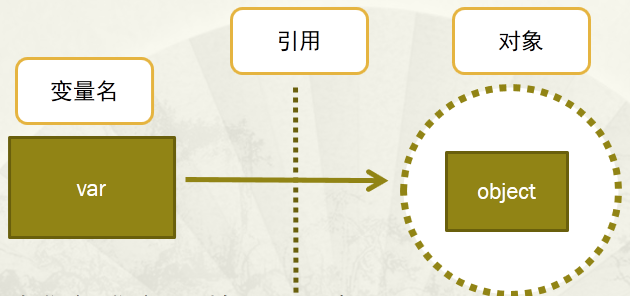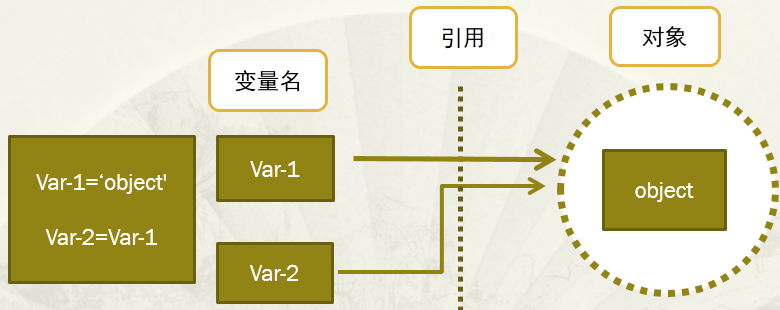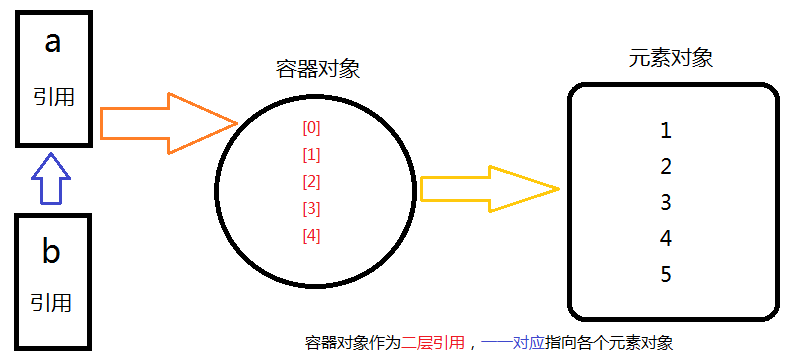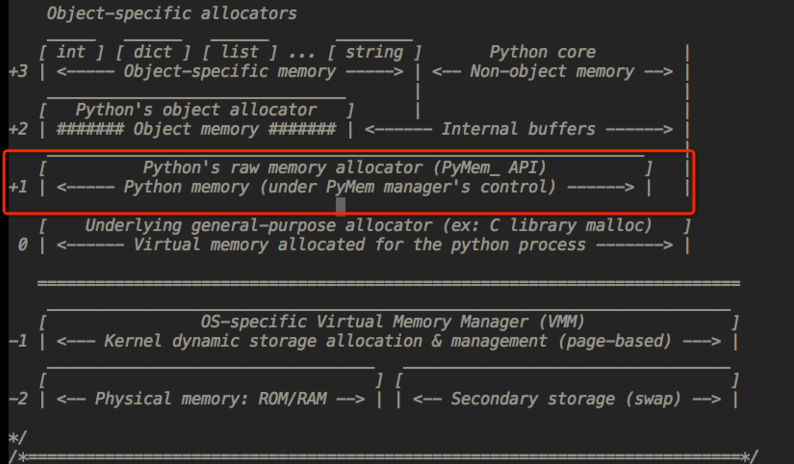一、变量与对象
关系图如下:

1、变量,通过变量指针引用对象
变量指针指向具体对象的内存空间,取对象的值。
2、对象,类型已知,每个对象都包含一个头部信息(头部信息:类型标识符和引用计数器)
注意:
变量名没有类型,类型属于对象(因为变量引用对象,所以类型随对象),变量引用什么类型的对象,变量就是什么类型的。
|
1 2 3 4 5 6 7 |
<span style="font-size: 16px;">In [32]: var1=<span style="color: rgba(0, 0, 0, 1);">object In [</span>33]: var2=<span style="color: rgba(0, 0, 0, 1);">var1 In [</span>34<span style="color: rgba(0, 0, 0, 1);">]: id(var1) Out[</span>34]: 139697863383968<span style="color: rgba(0, 0, 0, 1);"> In [</span>35<span style="color: rgba(0, 0, 0, 1);">]: id(var2) Out[</span>35]: 139697863383968</span> |
PS:id()是python的内置函数,用于返回对象的身份,即对象的内存地址。

|
1 2 3 4 5 6 7 8 9 10 11 12 13 14 15 16 |
<span style="font-size: 16px;">In [39]: a=123<span style="color: rgba(0, 0, 0, 1);"> In [</span>40]: b=<span style="color: rgba(0, 0, 0, 1);">a In [</span>41<span style="color: rgba(0, 0, 0, 1);">]: id(a) Out[</span>41]: 23242832<span style="color: rgba(0, 0, 0, 1);"> In [</span>42<span style="color: rgba(0, 0, 0, 1);">]: id(b) Out[</span>42]: 23242832<span style="color: rgba(0, 0, 0, 1);"> In [</span>43]: a=456<span style="color: rgba(0, 0, 0, 1);"> In [</span>44<span style="color: rgba(0, 0, 0, 1);">]: id(a) Out[</span>44]: 33166408<span style="color: rgba(0, 0, 0, 1);"> In [</span>45<span style="color: rgba(0, 0, 0, 1);">]: id(b) Out[</span>45]: 23242832</span> |
3、引用所指判断
通过is进行引用所指判断,is是用来判断两个引用所指的对象是否相同。
整数
|
1 2 3 4 |
<span style="font-size: 16px;">In [46]: a=1<span style="color: rgba(0, 0, 0, 1);"> In [</span>47]: b=1<span style="color: rgba(0, 0, 0, 1);"> In [</span>48]: <span style="color: rgba(0, 0, 255, 1);">print</span>(a <span style="color: rgba(0, 0, 255, 1);">is</span><span style="color: rgba(0, 0, 0, 1);"> b) True</span></span> |
短字符串
|
1 2 3 4 |
<span style="font-size: 16px;">In [49]: c=<span style="color: rgba(128, 0, 0, 1);">"</span><span style="color: rgba(128, 0, 0, 1);">good</span><span style="color: rgba(128, 0, 0, 1);">"</span><span style="color: rgba(0, 0, 0, 1);"> In [</span>50]: d=<span style="color: rgba(128, 0, 0, 1);">"</span><span style="color: rgba(128, 0, 0, 1);">good</span><span style="color: rgba(128, 0, 0, 1);">"</span><span style="color: rgba(0, 0, 0, 1);"> In [</span>51]: <span style="color: rgba(0, 0, 255, 1);">print</span>(c <span style="color: rgba(0, 0, 255, 1);">is</span><span style="color: rgba(0, 0, 0, 1);"> d) True</span></span> |
长字符串
|
1 2 3 4 |
<span style="font-size: 16px;">In [52]: e=<span style="color: rgba(128, 0, 0, 1);">"</span><span style="color: rgba(128, 0, 0, 1);">very good</span><span style="color: rgba(128, 0, 0, 1);">"</span><span style="color: rgba(0, 0, 0, 1);"> In [</span>53]: f=<span style="color: rgba(128, 0, 0, 1);">"</span><span style="color: rgba(128, 0, 0, 1);">very good</span><span style="color: rgba(128, 0, 0, 1);">"</span><span style="color: rgba(0, 0, 0, 1);"> In [</span>54]: <span style="color: rgba(0, 0, 255, 1);">print</span>(e <span style="color: rgba(0, 0, 255, 1);">is</span><span style="color: rgba(0, 0, 0, 1);"> f) False</span></span> |
列表
|
1 2 3 4 |
<span style="font-size: 16px;">In [55]: g=<span style="color: rgba(0, 0, 0, 1);">[] In [</span>56]: h=<span style="color: rgba(0, 0, 0, 1);">[] In [</span>57]: <span style="color: rgba(0, 0, 255, 1);">print</span>(g <span style="color: rgba(0, 0, 255, 1);">is</span><span style="color: rgba(0, 0, 0, 1);"> h) False</span></span> |
由运行结果可知:
1、Python缓存了整数和短字符串,因此每个对象在内存中只存有一份,引用所指对象就是相同的,即使使用赋值语句,也只是创造新的引用,而不是对象本身;
2、Python没有缓存长字符串、列表及其他对象,可以由多个相同的对象,可以使用赋值语句创建出新的对象。
在Python中,每个对象都有指向该对象的引用总数—引用计数
查看对象的引用计数:sys.getrefcount()
1、普通引用
|
1 2 3 4 5 6 7 8 9 10 11 |
<span style="font-size: 16px;">In [2]: <span style="color: rgba(0, 0, 255, 1);">import</span><span style="color: rgba(0, 0, 0, 1);"> sys In [</span>3]: a=[1,2,3<span style="color: rgba(0, 0, 0, 1);">] In [</span>4<span style="color: rgba(0, 0, 0, 1);">]: getrefcount(a) Out[</span>4]: 2<span style="color: rgba(0, 0, 0, 1);"> In [</span>5]: b=<span style="color: rgba(0, 0, 0, 1);">a In [</span>6<span style="color: rgba(0, 0, 0, 1);">]: getrefcount(a) Out[</span>6]: 3<span style="color: rgba(0, 0, 0, 1);"> In [</span>7<span style="color: rgba(0, 0, 0, 1);">]: getrefcount(b) Out[</span>7]: 3</span> |
注意:
当使用某个引用作为参数,传递给getrefcount()时,参数实际上创建了一个临时的引用。因此,getrefcount()所得到的结果,会比期望的多1。
2、容器对象
Python的一个容器对象(比如:表、词典等),可以包含多个对象。
|
1 2 3 4 5 6 7 8 9 10 11 12 13 14 15 |
<span style="font-size: 16px;">In [12]: a=[1,2,3,4,5<span style="color: rgba(0, 0, 0, 1);">] In [</span>13]: b=<span style="color: rgba(0, 0, 0, 1);">a In [</span>14]: a <span style="color: rgba(0, 0, 255, 1);">is</span><span style="color: rgba(0, 0, 0, 1);"> b Out[</span>14<span style="color: rgba(0, 0, 0, 1);">]: True In [</span>15]: a[0]=6<span style="color: rgba(0, 0, 0, 1);"> In [</span>16<span style="color: rgba(0, 0, 0, 1);">]: a Out[</span>16]: [6, 2, 3, 4, 5<span style="color: rgba(0, 0, 0, 1);">] In [</span>17]: a <span style="color: rgba(0, 0, 255, 1);">is</span><span style="color: rgba(0, 0, 0, 1);"> b Out[</span>17<span style="color: rgba(0, 0, 0, 1);">]: True In [</span>18<span style="color: rgba(0, 0, 0, 1);">]: b Out[</span>18]: [6, 2, 3, 4, 5]</span> |

由上可见,实际上,容器对象中包含的并不是元素对象本身,是指向各个元素对象的引用。
3、引用计数增加
1、对象被创建
|
1 2 3 4 5 6 7 |
<span style="font-size: 16px;">In [39]: getrefcount(123<span style="color: rgba(0, 0, 0, 1);">) Out[</span>39]: 6<span style="color: rgba(0, 0, 0, 1);"> In [</span>40]: n=123<span style="color: rgba(0, 0, 0, 1);"> In [</span>41]: getrefcount(123<span style="color: rgba(0, 0, 0, 1);">) Out[</span>41]: 7</span> |
2、另外的别人被创建
|
1 2 3 |
<span style="font-size: 16px;">In [42]: m=<span style="color: rgba(0, 0, 0, 1);">n In [</span>43]: getrefcount(123<span style="color: rgba(0, 0, 0, 1);">) Out[</span>43]: 8</span> |
3、作为容器对象的一个元素
|
1 2 3 |
<span style="font-size: 16px;">In [44]: a=[1,12,123<span style="color: rgba(0, 0, 0, 1);">] In [</span>45]: getrefcount(123<span style="color: rgba(0, 0, 0, 1);">) Out[</span>45]: 9</span> |
4、被作为参数传递给函数:foo(x)
4、引用计数减少
1、对象的别名被显式的销毁
|
1 2 3 |
<span style="font-size: 16px;">In [46]: <span style="color: rgba(0, 0, 255, 1);">del</span><span style="color: rgba(0, 0, 0, 1);"> m In [</span>47]: getrefcount(123<span style="color: rgba(0, 0, 0, 1);">) Out[</span>47]: 8</span> |
2、对象的一个别名被赋值给其他对象
|
1 2 3 |
<span style="font-size: 16px;">In [48]: n=456<span style="color: rgba(0, 0, 0, 1);"> In [</span>49]: getrefcount(123<span style="color: rgba(0, 0, 0, 1);">) Out[</span>49]: 7</span> |
3、对象从一个窗口对象中移除,或,窗口对象本身被销毁
|
1 2 3 4 5 6 |
<span style="font-size: 16px;">In [50]: a.remove(123<span style="color: rgba(0, 0, 0, 1);">) In [</span>51<span style="color: rgba(0, 0, 0, 1);">]: a Out[</span>51]: [1, 12<span style="color: rgba(0, 0, 0, 1);">] In [</span>52]: getrefcount(123<span style="color: rgba(0, 0, 0, 1);">) Out[</span>52]: 6</span> |
4、一个本地引用离开了它的作用域,比如上面的foo(x)函数结束时,x指向的对象引用减1。
当Python中的对象越来越多,占据越来越大的内存,启动垃圾回收(garbage collection),将没用的对象清除。
1、原理
当Python的某个对象的引用计数降为0时,说明没有任何引用指向该对象,该对象就成为要被回收的垃圾。比如某个新建对象,被分配给某个引用,对象的引用计数变为1。如果引用被删除,对象的引用计数为0,那么该对象就可以被垃圾回收。
|
1 2 3 |
<span style="font-size: 16px;">In [74]: a=[321,123<span style="color: rgba(0, 0, 0, 1);">] In [</span>75]: <span style="color: rgba(0, 0, 255, 1);">del</span> a</span> |
2、解析del
del a后,已经没有任何引用指向之前建立的[321,123],该表引用计数变为0,用户不可能通过任何方式接触或者动用这个对象,当垃圾回收启动时,Python扫描到这个引用计数为0的对象,就将它所占据的内存清空。
3、注意
1、垃圾回收时,Python不能进行其它的任务,频繁的垃圾回收将大大降低Python的工作效率;
2、Python只会在特定条件下,自动启动垃圾回收(垃圾对象少就没必要回收)
3、当Python运行时,会记录其中分配对象(object allocation)和取消分配对象(object deallocation)的次数。当两者的差值高于某个阈值时,垃圾回收才会启动。
|
1 2 3 4 |
<span style="font-size: 16px;">In [93]: <span style="color: rgba(0, 0, 255, 1);">import</span><span style="color: rgba(0, 0, 0, 1);"> gc In [</span>94]: gc.get_threshold() <span style="color: rgba(0, 128, 0, 1);">#</span><span style="color: rgba(0, 128, 0, 1);">gc模块中查看阈值的方法</span><span style="color: rgba(0, 0, 0, 1);"> Out[</span>94]: (700, 10, 10)</span> |
阈值分析:
700即是垃圾回收启动的阈值;
每10次0代垃圾回收,会配合1次1代的垃圾回收;而每10次1代的垃圾回收,才会有1次的2代垃圾回收;
当然也是可以手动启动垃圾回收:
|
1 2 |
<span style="font-size: 16px;">In [95]: gc.collect() <span style="color: rgba(0, 128, 0, 1);">#</span><span style="color: rgba(0, 128, 0, 1);">手动启动垃圾回收</span><span style="color: rgba(0, 0, 0, 1);"> Out[</span>95]: 2</span> |
4、何为分代回收
Python将所有的对象分为0,1,2三代;
所有的新建对象都是0代对象;
当某一代对象经历过垃圾回收,依然存活,就被归入下一代对象。
Python中有分为大内存和小内存:(256K为界限分大小内存)
1、大内存使用malloc进行分配
2、小内存使用内存池进行分配
3、Python的内存池(金字塔)
第3层:最上层,用户对Python对象的直接操作
第1层和第2层:内存池,有Python的接口函数PyMem_Malloc实现—–若请求分配的内存在1~256字节之间就使用内存池管理系统进行分配,调用malloc函数分配内存,但是每次只会分配一块大小为256K的大块内存,不会调用free函数释放内存,将该内存块留在内存池中以便下次使用。
第0层:大内存—–若请求分配的内存大于256K,malloc函数分配内存,free函数释放内存。
第-1,-2层:操作系统进行操作
